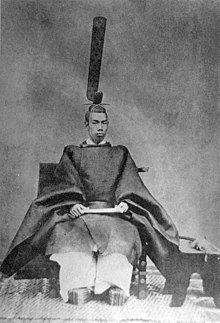| Meiji era 明治時代 | |||
|---|---|---|---|
| October 23, 1868 – July 30, 1912 | |||
 Emperor Meiji (1872) | |||
| Location | Japan | ||
| Including | |||
| Monarch(s) | Meiji | ||
| Key events | Meiji Restoration | ||
Chronology
| |||
| Part of a series on the |
| History of Japan |
|---|
 |
The Meiji era (明治時代, Meiji jidai, [meꜜː(d)ʑi] ) was an era of Japanese history that extended from October 23, 1868, to July 30, 1912.[1] The Meiji era was the first half of the Empire of Japan, when the Japanese people moved from being an isolated feudal society at risk of colonization by Western powers to the new paradigm of a modern, industrialized nation state and emergent great power, influenced by Western scientific, technological, philosophical, political, legal, and aesthetic ideas. As a result of such wholesale adoption of radically different ideas, the changes to Japan were profound, and affected its social structure, internal politics, economy, military, and foreign relations. The period corresponded to the reign of Emperor Meiji. It was preceded by the Keiō era and was succeeded by the Taishō era, upon the accession of Emperor Taishō.
The rapid modernization during the Meiji era was not without its opponents, as the rapid changes to society caused many disaffected traditionalists from the former samurai class to rebel against the Meiji government during the 1870s, most famously Saigō Takamori, who led the Satsuma Rebellion. However, there were also former samurai who remained loyal while serving in the Meiji government, such as Itō Hirobumi and Itagaki Taisuke.
- ^ Nussbaum, Louis-Frédéric. (2005). "Meiji" in Japan encyclopedia, p. 624, p. 624, at Google Books; n.b., Louis-Frédéric is pseudonym of Louis-Frédéric Nussbaum, see Deutsche Nationalbibliothek Authority File.